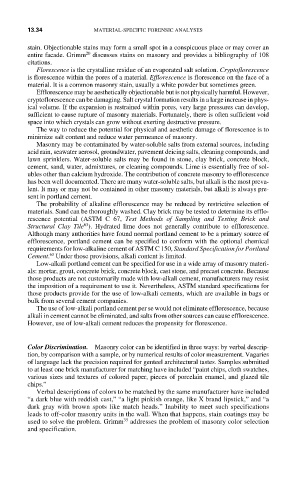Page 489 - Forensic Structural Engineering Handbook
P. 489
13.34 MATERIAL-SPECIFIC FORENSIC ANALYSES
stain. Objectionable stains may form a small spot in a conspicuous place or may cover an
20
entire facade. Grimm discusses stains on masonry and provides a bibliography of 108
citations.
Florescence is the crystalline residue of an evaporated salt solution. Cryptoflorescence
is florescence within the pores of a material. Efflorescence is florescence on the face of a
material. It is a common masonry stain, usually a white powder but sometimes green.
Efflorescence may be aesthetically objectionable but is not physically harmful. However,
cryptoflorescence can be damaging. Salt crystal formation results in a large increase in phys-
ical volume. If the expansion is restrained within pores, very large pressures can develop,
sufficient to cause rupture of masonry materials. Fortunately, there is often sufficient void
space into which crystals can grow without exerting destructive pressure.
The way to reduce the potential for physical and aesthetic damage of florescence is to
minimize salt content and reduce water permeance of masonry.
Masonry may be contaminated by water-soluble salts from external sources, including
acid rain, seawater aerosol, groundwater, pavement deicing salts, cleaning compounds, and
lawn sprinklers. Water-soluble salts may be found in stone, clay brick, concrete block,
cement, sand, water, admixtures, or cleaning compounds. Lime is essentially free of sol-
ubles other than calcium hydroxide. The contribution of concrete masonry to efflorescence
has been well documented. There are many water-soluble salts, but alkali is the most preva-
lent. It may or may not be contained in other masonry materials, but alkali is always pre-
sent in portland cement.
The probability of alkaline efflorescence may be reduced by restrictive selection of
materials. Sand can be thoroughly washed. Clay brick may be tested to determine its efflo-
rescence potential (ASTM C 67, Test Methods of Sampling and Testing Brick and
63
Structural Clay Tile ). Hydrated lime does not generally contribute to efflorescence.
Although many authorities have found normal portland cement to be a primary source of
efflorescence, portland cement can be specified to conform with the optional chemical
requirements for low-alkaline cement of ASTM C 150, Standard Specification for Portland
63
Cement. Under those provisions, alkali content is limited.
Low-alkali portland cement can be specified for use in a wide array of masonry materi-
als: mortar, grout, concrete brick, concrete block, cast stone, and precast concrete. Because
those products are not customarily made with low-alkali cement, manufacturers may resist
the imposition of a requirement to use it. Nevertheless, ASTM standard specifications for
those products provide for the use of low-alkali cements, which are available in bags or
bulk from several cement companies.
The use of low-alkali portland cement per se would not eliminate efflorescence, because
alkali in cement cannot be eliminated, and salts from other sources can cause efflorescence.
However, use of low-alkali cement reduces the propensity for florescence.
Color Discrimination. Masonry color can be identified in three ways: by verbal descrip-
tion, by comparison with a sample, or by numerical results of color measurement. Vagaries
of language lack the precision required for genteel architectural tastes. Samples submitted
to at least one brick manufacturer for matching have included “paint chips, cloth swatches,
various sizes and textures of colored paper, pieces of porcelain enamel, and glazed tile
chips.”
Verbal descriptions of colors to be matched by the same manufacturer have included
“a dark blue with reddish cast,” “a light pinkish orange, like X brand lipstick,” and “a
dark gray with brown spots like match heads.” Inability to meet such specifications
leads to off-color masonry units in the wall. When that happens, stain coatings may be
35
used to solve the problem. Grimm addresses the problem of masonry color selection
and specification.

